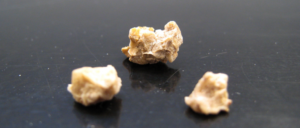Yesterday's post on the possibility of riding "medium intensity" (think old fashioned) roller coasters to dislodge and pass kidney stones was amusing, but now I've read of another interesting way to facilitate passing of kidney stones. One study of Turkish men found that having sex 3 to 4 times a week promoted passage of kidney stones under 6 mm in size. Kidney stones are small, hard mineral deposits that form inside the kidneys, affecting up to 15 percent of people in developed countries.
on the possibility of riding "medium intensity" (think old fashioned) roller coasters to dislodge and pass kidney stones was amusing, but now I've read of another interesting way to facilitate passing of kidney stones. One study of Turkish men found that having sex 3 to 4 times a week promoted passage of kidney stones under 6 mm in size. Kidney stones are small, hard mineral deposits that form inside the kidneys, affecting up to 15 percent of people in developed countries.
All the men in the 3 groups (Sexual intercourse group, Tamsulosin group, and Control group) were also told to drink 2 liters of water a day to help expel kidney stones. Note that tamsulosin (also called Flomax) is a drug used to improve urination and to help with the passage of kidney stones. They found that after 2 weeks: 83.9% of the Sexual Intercourse group, 47.6% of the Tamsulosin group, and 34.8% of the Control group had successfully passed kidney stones, and after 4 weeks: 93.5% of the Sexual Intercourse group, 81% of the Tamsulosin group, and 78.3% of the Control group had done so. Frequent sex appeared to work, especially in speeding up the process! From the journal Urology:
OBJECTIVE: To investigate the effect of sexual intercourse on spontaneous passage of distal ureteral stones.
The patients were randomly divided into 3 groups with random number table envelope method. Patients in group 1 were asked to have sexual intercourse at least 3-4 times a week. Patients in group 2 were administered tamsulosin 0.4 mg/d. Patients in group 3 received standard medical therapy alone and acted as the controls. The expulsion rate was controlled after 2 and 4 weeks. Differences in the expulsion rate between groups were compared with the chi-square test for 3 × 2 tables. P <.05 was considered as statistically significant.
The mean stone size was 4.7 ± 0.8 mm in group 1, 5 ± 1 mm group 2, and 4.9 ± 0.8 mm group 3 (P = .4). Two weeks later, 26 of 31 patients (83.9%) in the sexual intercourse group, and 10 of 21 patients (47.6%) in tamsulosin group passed their stones, whereas 8 of 23 patients (34.8%) in the control group passed their stones (P = .001). The mean stone expulsion time was 10 ± 5.8 days in group 1, 16.6 ± 8.5 days in group 2, and 18 ± 5.5 days in group 3 (P = .0001).
Our results have indicated that patients who have distal ureteral stones ≤6 mm and a sexual partner may be advised to have sexual intercourse 3-4 times a week to increase the probability of spontaneous passage of the stones.
